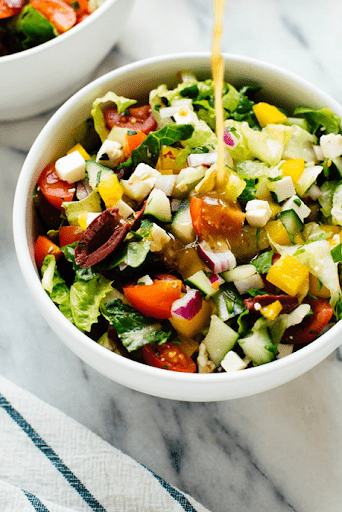BLOGS
Mediterranean Diet 101: a Guide for the Filipino Palate
One would not fully enjoy Vista Alabang’s Italian-themed luxury properties if they didn’t follow Italian ways of living. One of these is incorporating the Mediterranean diet.
Today, most people think of a “diet” as something that is based on restriction and helps you lose weight. The Mediterranean diet is the polar opposite of that. Rather, it’s a heart-healthy eating pattern that incorporates the staple foods of people who reside in countries around the Mediterranean Sea like Greece, Croatia, and Italy.
The term “Mediterranean diet” refers to the typical eating patterns of countries that surround the Mediterranean Sea. There is no one-size-fits-all Mediterranean diet. The Mediterranean is bordered by at least 16 nations. Because of differences in culture, ethnic background, religion, economy, geography, and agricultural production, eating styles differ between various countries and even between regions within each country. There are, nevertheless, certain commonalities.
You may have heard about popular diets like paleo, ketogenic (or keto), Atkins, interval, zone, and Whole30. Keep in mind, not all trendy diets meet the American Heart Association’s science-based criteria for a healthy eating pattern. Some show dramatic but short-term results and are not heart-healthy, unlike the Mediterranean diet.
They emphasize a plant-based eating style rich in vegetables and healthy fats, such as olive oil and omega-3 fatty acids from fish, in their meals. It’s a diet that’s recognized to be good for your heart. You’ll limit or avoid red meat, sugary foods, and dairy on this diet. But of course, small amounts of yogurt and cheese may be included.
When you eat this way, you have less space for processed foods. Conventional proteins like chicken may be more of a side dish compared to produce, which becomes the main event when looking at a plate; traditional proteins like chicken may be more of a side dish compared to produce, which becomes the main event when looking at a plate.
The Mediterranean diet allows for low to moderate amounts of red wine, which is something that many individuals enjoy. 5 ounces (oz) or less per day (about one glass) is considered “moderate.” It’s worth emphasizing, though, that a daily glass of wine isn’t required on this diet, and if you don’t already drink, this limit isn’t a mandate to begin.
So, if you’re one of the special few who purchased Italian-themed luxury homes in Daang Hari, or maybe just a person interested in the Italian way of life, then here is a guide for you to start your Mediterranean diet.
What to Include on Your Plate for Your Mediterranean Diet
How can you incorporate these healthy foods into your everyday life? A Mediterranean-style diet typically includes plenty of fruits, vegetables, bread and other grains, potatoes, beans, nuts, and seeds; olive oil as a primary fat source; and dairy products, eggs, fish, and poultry in low to moderate amounts.
Fish and poultry are more common than red meat in this diet. It also centers on minimally processed, plant-based foods. Wine may be consumed in low to moderate amounts, usually with meals. Fruit is a common dessert instead of sweets.
1. Reduce your meat consumption. Choose lean poultry that is 3 to 4 ounces in size. Save red meat for special occasions or use it as a condiment in stews, stir-fries, and soups with plenty of veggies. Increase your fish consumption to two to three servings per week. Both canned and fresh fish are acceptable options.
2. Consume at least three servings of legumes every week. Lentils, chickpeas, beans, and peas are among the options.
3. Wine can be substituted for other alcoholic beverages in moderation. Wine should be substituted for beer or liquors, with no more than two 5-ounce glasses per day for males and one glass for women.
4. Toss in some whole-wheat bread or other nutritious grains to round out the meal. Choose country-style loaves that are dense, chewy, and free of added sugar or butter. Bulgur, barley, farro, couscous, and whole-grain pasta are all good options.
5. Reduce your intake of high-fat, high-sugar treats. The best fruit is poached or fresh. Three servings of fresh fruit every day is a good goal. Cakes and pastries should be saved for exceptional occasions.
6. Increase the number and variety of veggies on the menu. Increase the number of veggies you eat at lunch and dinner to three to four servings per day. Every week, try a new veggie.
7. Sugary drinks should be avoided. Water should be substituted for soda and juices.
8. Replace whatever fats you’re currently using with extra virgin olive oil. Begin with cooking using olive oil, and then experiment with creative salad dressings using olive oil as the base. Finally, instead of butter, use olive oil on your crusty bread.
9. Nuts and olives are good to eat. As a healthy alternative to manufactured snacks, eat a handful of raw nuts every day.
10. Salad should be served at the start or finish of each meal. Crisp, dark greens, and whatever vegetables are in season are the best choices.
All of these ingredients and foods are available in AllDay Grocery in Evia Lifestyle Center. A mall right beside the luxury house and lot properties for sale in Portofino Alabang.
A Daily Meal Plan Reimagined for a Mediterranean Diet
One good thing about the Filipino palate is that it is used to a wide range of flavor profiles, thanks to the Chinese, Southeast Asian, American, and Spanish influences in our cuisine. A Filipino cook can easily switch from seasoning with soy sauce, vinegar, and fish sauce to cooking with butter, olive oil, and cream; and that is why adopting the healthy Mediterranean diet to the Filipino kitchen would be a cinch. It’s truly a matter of selecting ingredients more carefully, cooking more mindfully, and eating more purposefully.
Breakfast
Breakfast is a simple way to get started with the Mediterranean diet. Go for Greek yogurt, which contains double the protein and half the sugar of conventional yogurt for the same calories, topped with fresh fruit, berries, and a sprinkle of nuts.

You can also make this veggie-packed breakfast sandwich made with multigrain sandwich thins, egg, reduced-fat feta cheese, baby spinach leaves, tomato, and olive oil.

You might also like this loaded vegetable omelette made with cherry tomatoes, Kalamata olives, marinated artichoke hearts, fresh parsley, fresh mint, and crumbled feta cheese.
Lunch
Lunch is a great opportunity for Mediterranean meals. For example, you can enjoy a grain or legume-based salad that gently raises blood sugar, giving your brain the energy it requires to go through the day.

Or try chopped mixed greens, kalamata olives, tomatoes, fresh parsley, and feta cheese are used in this Greek salad. Extra virgin olive oil and freshly squeezed lemon juice are used to dress the salad.

And if you miss pizza, try Part-skim mozzarella cheese, roasted broccoli, onions, green peppers, and carrots top a vegetarian pizza.
Dinner
Enjoy The typical Mediterranean diet avoids red and processed meats, while fish and other shellfish are consumed at least twice a week in your Italian-themed luxury home in Portofino Alabang. Try this salmon with roasted grape salsa dish, which features a vibrant blend of roasted red grapes, red peppers, green peppers, red onions, lemon juice, and cilantro.
Or mix it up with broccoli, cauliflower, asparagus, and yellow peppers are stir-fried with chicken in olive oil and served over brown rice. Enjoy these dishes in the dining rooms of luxury homes in Daang Hari.
Dessert

You would imagine you’ll gorge yourself on Mediterranean goodies like baklava, tiramisu, cannoli, gelato, flan, and crème brûlée, but for Italian living, these are reserved for special occasions. Why not choose whole, sliced, or grilled fruit, or a nutritious combination of whole-grain granola parfaits, ricotta, and freshly grated orange zest.
Do you know what goes perfectly with these desserts? Your very own house courtyard to relax and enjoy your dessert in. One of the most beautiful houses in the Philippines is Portofino Alabang’s Raffaello ready for occupancy home, which is designed with a beautiful courtyard for your family to enjoy an afternoon tea or desserts in.
Studies that Prove the Mediterranean Diet has Health Benefits
The Mediterranean diet is also touted as one of the healthiest by many health organizations and dietitians. So, does it live up to its good reputation?
The Mediterranean diet can help reduce the risk of getting heart diseases with Healthy fats
This diet is well known for its heart-health benefits, lowering the risk of heart disease through lowering LDL (the bad kind) cholesterol levels and lowering mortality from cardiovascular diseases. Obesity, diabetes, high cholesterol, and high blood pressure are all risk factors for heart disease and stroke, and this way of eating can help prevent them. A Mediterranean diet high in virgin olive oil may help the body remove extra cholesterol from arteries and keep blood vessels open, according to some studies..
According to Mayo Clinic on heart health, olive oil is the principal source of added fat for this diet. Monounsaturated fats, such as those found in olive oil, help to lower total cholesterol and LDL cholesterol levels. Monounsaturated fat can also be found in nuts and seeds. Omega-3 fatty acids are abundant in fatty fish such as mackerel, herring, sardines, albacore tuna, and salmon. These polyunsaturated fats assist the body combat inflammation. Omega-3 fatty acids also aid in the reduction of triglycerides, the prevention of blood clotting, and the prevention of stroke and heart failure.
In addition, the American Heart Association recommends emphasizing vegetables, fruits, whole grains, beans, and legumes; including low-fat or fat-free dairy products, fish, poultry, non-tropical vegetable oils, and nuts; and limiting added sugars, sugary beverages, sodium, highly processed foods, refined carbohydrates, saturated fats, and fatty or processed meats in a healthy dietary pattern. All of these things are compatible with the Mediterranean diet.
This diet can aid in the prevention and management of type 2 diabetes.
A growing body of evidence suggests that the Mediterranean diet can help people lose weight while both having reduced risk and managing type 2 diabetes. For one thing, Mediterranean food improves blood sugar management among those who have already been diagnosed with diabetes, implying that it may be a useful strategy to treat the condition. Furthermore, because people with diabetes have a higher risk of cardiovascular disease, following this diet can help them improve their heart health.
In a study published in the journal Diabetes Care, it found that the diet seems to prevent type 2 diabetes. Researchers randomized a subgroup of 418 adults without diabetes aged 55 to 80 from the PREDIMED project and followed up with them after four years to check if they had developed diabetes. A Mediterranean diet without calorie restriction appears to prevent the development of type 2 diabetes, according to the researchers. Those who followed the Mediterranean diet for four years, whether supplementing with olive oil or nuts, had a 52 percent decreased risk of type 2 diabetes, even if they didn’t lose weight or exercise more.
In addition, a meta-analysis of 20 randomized clinical trials published in the American Journal of Clinical Nutrition in January 2013 found that low-carbohydrate, low-GI, Mediterranean, and high-protein diets are effective in improving various markers of cardiovascular risk in people with diabetes and should be considered in the overall diabetes management strategy. It was discovered that in people with type 2 diabetes, the Mediterranean diet improved blood sugar control more than the low-carbohydrate, low-glycemic index, and high-protein diets. This research implies that following a Mediterranean diet can help prevent type 2 diabetes-related health problems.
It is a good intervention against certain types of cancer.
In a study of 7,216 people, a total of 323 persons died including 81 deaths due to heart disease and 130 deaths due to cancer. Those who ate nuts had a 16–63 percent lower risk of death during the course of the trial. They discovered that eating nuts as part of a Mediterranean diet lowers the chance of dying substantially.
Based on PREDIMED data in October 2015 in the journal JAMA Internal Medicine found that women who ate a Mediterranean diet supplemented with extra-virgin olive oil had a 62 percent lower risk of breast cancer than those who ate a low-fat diet. On the other hand, adherence to the Mediterranean diet, according to a meta-analysis and review of 83 research published in the journal Nutrients in October 2017, may help reduce the incidence of malignancies like breast cancer and colorectal cancer, as well as cancer-related death. It found that higher intakes of fruits, vegetables, and whole grains are primarily responsible for the observed positive impacts.
The Mediterranean diet can for sure help with weight loss.
The Mediterranean diet, which focuses on whole, fresh foods, may help you lose weight safely and sustainably, but if you’re seeking quick results, you might be better off trying a different diet plan. As previously indicated, the Mediterranean diet was ranked No. 1 in the Best Diets Overall category by U.S. News & World Report in 2019, yet it tied for 17th place among the website’s Best Weight Loss Diets.
The Mediterranean diet may produce more dramatic benefits when calorie restriction is added, though it will not necessarily outperform another popular diet plan. In a two-year randomized clinical experiment, 322 moderately obese middle-aged men in Israel were randomly assigned to one of three diets: calorie-restricted low-fat, calorie-restricted Mediterranean, or calorie-unrestricted low-carb.
Looking for luxurious house and lots to match your diet? Check out these Italian-themed properties for sale at Brittany.
Visit Brittany’s official property page to know more about Brittany’s beautiful thematic offerings or follow us on our Linkedin, Facebook, Twitter, and Instagram accounts!


















